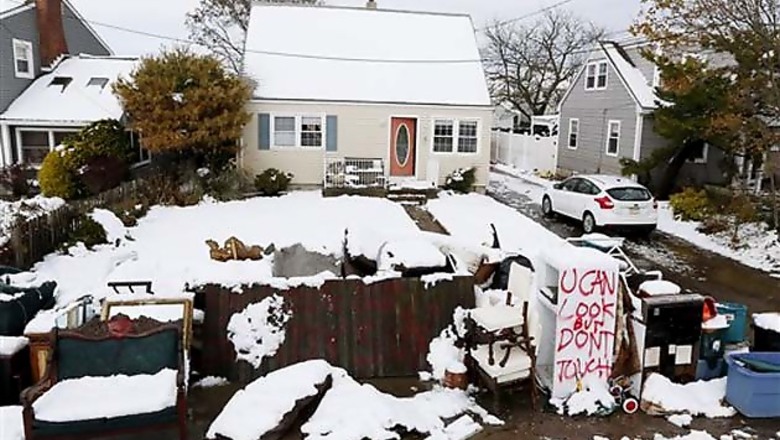
views
New York: New York City and much of the US Northeast on Thursday dug out from a snowstorm that hammered a region still struggling to recover from the devastation of superstorm Sandy. The unseasonably early winter storm dumped more than a foot of snow on parts of Connecticut and slapped the region with 50 mph winds, plunging hundreds of thousands of homes and businesses back into darkness and creating a new commuting nightmare for a region whose transportation system was already under repair.
Bitter cold, rain, snow and powerful winds added to the misery of disaster victims whose homes were destroyed or power was knocked out by Sandy, which smashed ashore on October 29 and caused widespread flooding. "God hates us!" the New York Post said in a front-page headline. Some 3 to 6 inches of snow fell on the city, which awoke to dry weather.
New York Governor Andrew Cuomo fired the state's emergency management chief, Steven Kuhr, for sending government workers to Kuhr's Long Island home to clear a tree toppled by Sandy, according to media reports.
Some 715,000 homes and businesses in the region were without power, an increase of nearly 43,000 from Wednesday night after the nor'easter knocked power out to more customers following those who had lost power due to Sandy, the US Department of Energy said.
"I thought I was lucky when power was restored last Thursday, but last night it went out again," said Michael Platt, 49, an electrician from Toms River, New Jersey, who estimated a foot of snow fell in his area. "The kids have been home for nearly two weeks and I'm not working, and when I'm not working I'm not making any money. This hasn't been easy."
The storms battered New Jersey's shore, a summer tourist haven where hundreds of beachfront homes were destroyed by Sandy's record storm surge.
'Enough is enough'
Sandy's death toll in the United States and Canada reached 121 after New York authorities on Wednesday reported another death linked to the storm in the hard-hit coastal neighborhood of the Rockaways, a barrier island facing the Atlantic Ocean.
"Can you believe this? Enough is enough," said Cindy Casey, whose Belle Harbor home one block from the beach in the Rockaways was swamped by Sandy, as she looked out at the snow blanketing the neighborhood devastated by flooding and fire.
Sandy surrounded Casey's home with six feet (two meters) of water and sparked a fire that destroyed at least 20 houses in the neighborhood before stopping short of her own.
"I said, 'I'm going to die,'" said Casey, who does not know how to swim but vows to learn. "It was non-stop. I just felt hopeless. There was nothing I could do. ... At least I still have a house."
New York and New Jersey evacuated the most vulnerable coastal areas ahead of the nor'easter storm. New York City officials urged people whose homes have been flooded by Sandy to relocate to the homes of friends or family members or to go to city shelters. The city also distributed space heaters and blankets to residents without heat or power and opened shelters to those in need of a warm place to sleep.
Commuter bus and train services had been disrupted by the storm, with the Long Island Rail Road briefly shutting down all operations to the city's eastern suburbs on Wednesday night.
All of the region's major airports experienced canceled flights and delays on Wednesday due to the storm, and gasoline remained in short supply. Four companies told the United States they intended to take advantage of a rare waiver allowing them to use foreign-flagged ships to transport oil products to the storm-hit region.




















Comments
0 comment